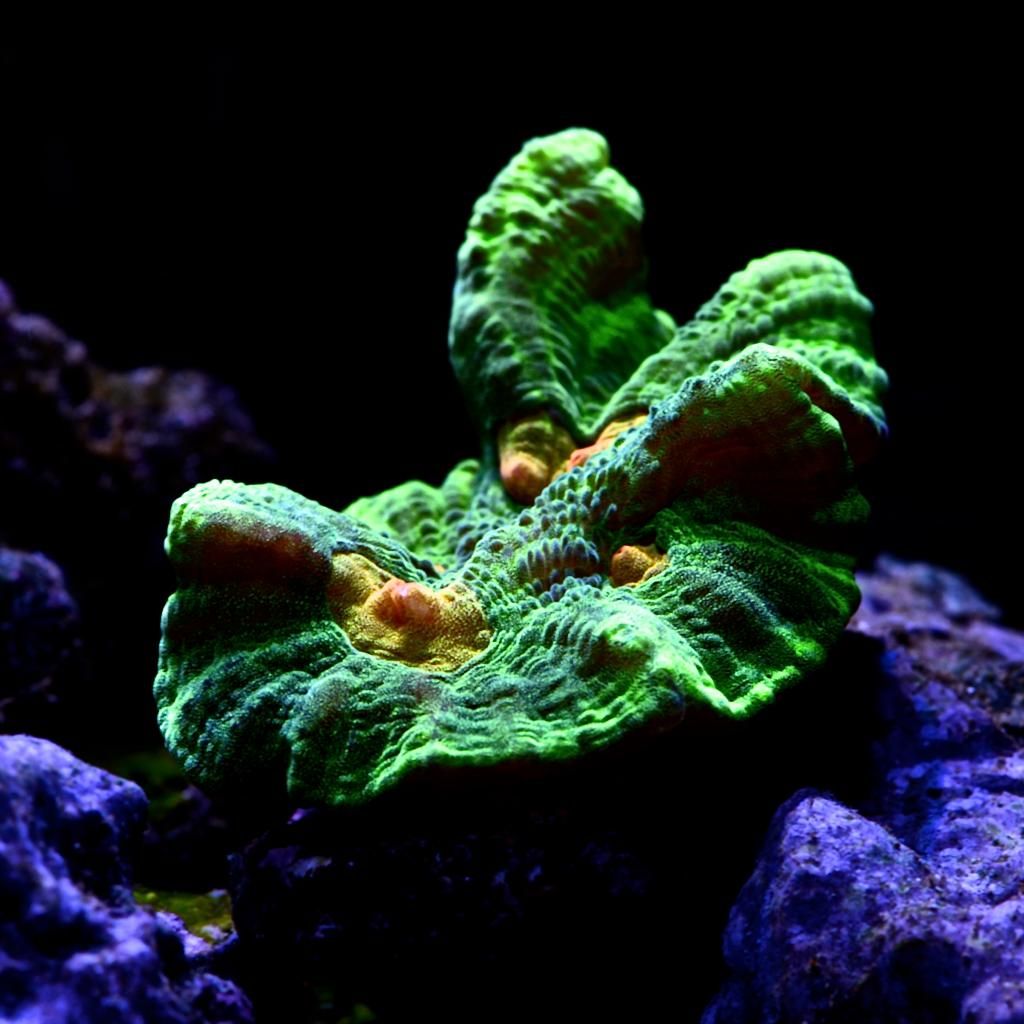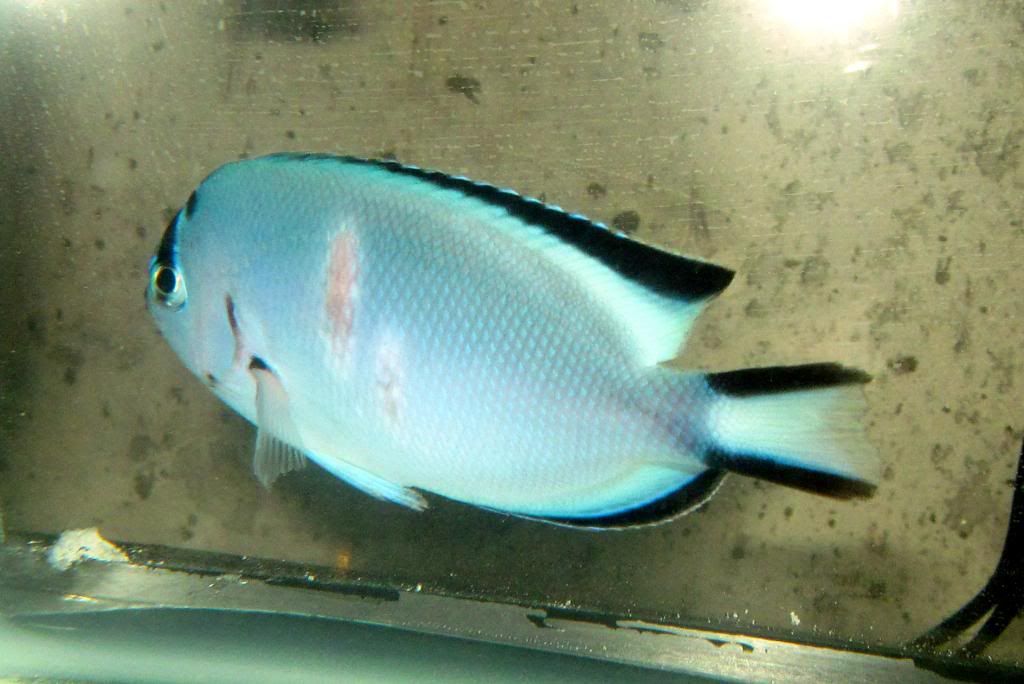| Author |
 Topic Search Topic Search  Topic Options Topic Options
|
ReefdUp 
Guest


Joined: March 20 2011
Location: South Weber
Status: Offline
Points: 4166
|
 Post Options Post Options
 Thanks(0) Thanks(0)
 Quote Quote  Reply Reply
 Topic: Black turbellarian worms Topic: Black turbellarian worms
Posted: March 28 2013 at 8:58pm |
|
Anyone have any experience with these? I can't find great info...
I'm currently doing a freshwater dip with methylene blue.
I'm debating....prazipro bath or hyposalinity next?
|
|
www.reefdup.com
Diving since 2009, reefkeeping since 2007, & fishkeeping since 1987
200g, 75g, & 15g Systems
PADI Advanced Open Water
|
 |
Ann_A 
Guest


Joined: August 18 2011
Location: Kaysville, UT
Status: Offline
Points: 2767
|
 Post Options Post Options
 Thanks(0) Thanks(0)
 Quote Quote  Reply Reply
 Posted: March 28 2013 at 9:00pm Posted: March 28 2013 at 9:00pm |
|
Personally I'd do hyposalinity since that seems like it would cause less stress on the fish because it's more "natural" rather than using chemicals. Just my 2 cents.
Edited by Ann_A - March 28 2013 at 10:16pm
|
|
|
 |
ReefdUp 
Guest


Joined: March 20 2011
Location: South Weber
Status: Offline
Points: 4166
|
 Post Options Post Options
 Thanks(0) Thanks(0)
 Quote Quote  Reply Reply
 Posted: March 28 2013 at 9:08pm Posted: March 28 2013 at 9:08pm |
|
I'm going to do prazi and hypo...just not sure of which order.
I'm leaning toward hypo too, but it sounds like prazi may work faster on this....
But she will probably get ich....so hypo would help with that....
Edited by ReefdUp - March 28 2013 at 10:20pm
|
|
www.reefdup.com
Diving since 2009, reefkeeping since 2007, & fishkeeping since 1987
200g, 75g, & 15g Systems
PADI Advanced Open Water
|
 |
ClownFishAddict 
Guest


Joined: December 18 2012
Location: West Jordan
Status: Offline
Points: 851
|
 Post Options Post Options
 Thanks(0) Thanks(0)
 Quote Quote  Reply Reply
 Posted: March 28 2013 at 9:09pm Posted: March 28 2013 at 9:09pm |
Don't know why but I had this bookmarked and this is what it says: | Tang Turbellarian, Black Ich, Black Spot Disease
|  |
| Tang Turbellarian, Black Ich, Black Spot Disease |
|
Cause: Planarian; Ichthyophaga sp., Paravortex sp.
Description: Flukes can infect fish by attaching to the gills or
body wall and sucking blood or body fluids. Hooks generally attach the
parasite to the host. Those flukes that are monogenetic are able to
reproduce in an aquarium and become a problem. Larvae are free swimming
and find a host to which they attach. Adults are able to crawl from
host to host - they are unable to swim. If a fish knocks them off they
will likely die because they must crawl to another host.
At least 2 genera, Paravortex or Ichthyophaga, can cause
tang turbellarian, a fairly common disease. The larvae appear as tiny
black dots on the surface of a brightly colored fish, feeding on the
blood of their host. The worm releases from the host and falls to the
tank bottom to become an adult, which reproduces to make free-swimming
worms that find new hosts. Repeated cycles of reproduction can produce
heavily infected fish.
Symptoms: Small black dots (larvae) appear on the sides and fins
of affected fish. They may have rapid breathing and stop feeding.
Affected fish will scratch themselves on surfaces and swim erratically.
They may also breathe abnormally and lose their appetite.
Treatment: As the flukes are dislodged by treatment, care must
be taken to avoid knocking them off in the main aquarium which may allow
them to reach another host. Treatment should be done in a hospital
tank:
- Freshwater baths, with formalin and malachite green. Parasites will fall off and should be destroyed.
- Praziquantel: 1-5 mg/L hospital tank.
- Trichlorfon (Dylox®) 1.0 mg/L daily for 3 days.
Drug Details For The Treatment of Tang Turbellarian, Black Ich, Black Spot Disease:
| Name | Dosage | Action | Precaution | Dangers | | Formalin | 37% stock, .03 ml/L prolonged; 0.125 - 0.25 ml/L for brief dips | enzyme and cell membrane protein disruption | toxic to fish and humans | algae, invertebrates, fish above 80°F | | Malachite green | 2 mg/l brief dip, 0.1 mg/L continuous | binds and denatures intracellular proteins | carcinogenic, toxic | poisonous to fish | | Freshwater Dip | equalize pH, temperature, 5 minute limit | causes osmotic imbalance that leads to plasmolysis - rupture of the cell | toxic procedure, difficult to move and handle sick fish without harming them further | not used on fish with open wounds | | Praziquantel | 1 mg/L/3-5 days aqueous; 2.5 mg/1 g food orally | either causes calcium imbalance and parasite paralysis or prevents parasite purine sysnthesis | must be used in a hosptital tank | kills some invertebrates, such as feather duster worms |
|
|
|
|
 |
ReefdUp 
Guest


Joined: March 20 2011
Location: South Weber
Status: Offline
Points: 4166
|
 Post Options Post Options
 Thanks(0) Thanks(0)
 Quote Quote  Reply Reply
 Posted: March 28 2013 at 10:15pm Posted: March 28 2013 at 10:15pm |
|
Thanks ClownfishAddict... This was the one thing I didn't have bookmarked. I did the freshwater dip with methylene blue, and most of the black spots are gone (yay!) I will say...they left some serious wounds on her. Gotta start antibiotics soon...
Unfortunately, she also has marine velvet (amyloodinium). I started formalin...we'll see how this goes. After the velvet is gone..then I'll worry about the rest of it.
Edited by ReefdUp - March 28 2013 at 10:20pm
|
|
www.reefdup.com
Diving since 2009, reefkeeping since 2007, & fishkeeping since 1987
200g, 75g, & 15g Systems
PADI Advanced Open Water
|
 |
ReefdUp 
Guest


Joined: March 20 2011
Location: South Weber
Status: Offline
Points: 4166
|
 Post Options Post Options
 Thanks(0) Thanks(0)
 Quote Quote  Reply Reply
 Posted: March 28 2013 at 11:29pm Posted: March 28 2013 at 11:29pm |
|
Good news...maybe. She's swimming around and her breathing rate is slowing.
On a side note...no, this is not my fish (well, I want it to be, but technically I'm just saving her right now.)
|
|
www.reefdup.com
Diving since 2009, reefkeeping since 2007, & fishkeeping since 1987
200g, 75g, & 15g Systems
PADI Advanced Open Water
|
 |
ReefdUp 
Guest


Joined: March 20 2011
Location: South Weber
Status: Offline
Points: 4166
|
 Post Options Post Options
 Thanks(0) Thanks(0)
 Quote Quote  Reply Reply
 Posted: March 29 2013 at 8:09pm Posted: March 29 2013 at 8:09pm |
|
Here's an overview and an update:
28 March:
8pm - received fish, noticed black turbellarian worms. Fish was gasping, jumping out of the water, and the water smelled of ammonia. Noticed she also had Amyloodinium (velvet.) Fish was very lethargic, twitchy, and kept lying on her side.
9pm - Gave a 30 minute freshwater/methylene blue dip. Placed into QT treatment with Formalin. Breathing rate was approximately 180 breaths per minute. All noticeable worms fell off during the freshwater dip, but they left rather severe wounds. (Of course...used proper acclimation).
29 March:
8pm - She survived the first 24 hours. Still no appetite. Gave a second 10 minute freshwater/methylene blue dip. Switched her into QT #2 tank with a new dose of Formalin. Breathing rate is down to about 70 breaths per minute. Still slightly twitchy, but very active. Skin tone is less "velvety", but it's not gone yet. No sign of black turbellarian worms.
Edited by ReefdUp - March 29 2013 at 8:10pm
|
|
www.reefdup.com
Diving since 2009, reefkeeping since 2007, & fishkeeping since 1987
200g, 75g, & 15g Systems
PADI Advanced Open Water
|
 |
ClownFishAddict 
Guest


Joined: December 18 2012
Location: West Jordan
Status: Offline
Points: 851
|
 Post Options Post Options
 Thanks(0) Thanks(0)
 Quote Quote  Reply Reply
 Posted: March 29 2013 at 8:20pm Posted: March 29 2013 at 8:20pm |
Thats good news. 
|
|
|
 |
Nails12 
Guest


Joined: May 14 2012
Location: Draper
Status: Offline
Points: 1130
|
 Post Options Post Options
 Thanks(0) Thanks(0)
 Quote Quote  Reply Reply
 Posted: March 29 2013 at 9:28pm Posted: March 29 2013 at 9:28pm |
|
Go NIKKI!!!!!
|
|
This is more than a hobby; its a lifestyle.
|
 |
ReefdUp 
Guest


Joined: March 20 2011
Location: South Weber
Status: Offline
Points: 4166
|
 Post Options Post Options
 Thanks(0) Thanks(0)
 Quote Quote  Reply Reply
 Posted: March 29 2013 at 9:50pm Posted: March 29 2013 at 9:50pm |
|
Don't jinx me!!! Velvet is terrible to fight.
|
|
www.reefdup.com
Diving since 2009, reefkeeping since 2007, & fishkeeping since 1987
200g, 75g, & 15g Systems
PADI Advanced Open Water
|
 |
ReefdUp 
Guest


Joined: March 20 2011
Location: South Weber
Status: Offline
Points: 4166
|
 Post Options Post Options
 Thanks(0) Thanks(0)
 Quote Quote  Reply Reply
 Posted: March 31 2013 at 9:10pm Posted: March 31 2013 at 9:10pm |
Looks like she got a secondary infection. I'm treating with Furan 2, but it's not helping. Any other ideas? :( I think it probably hit her bloodstream...which means that's it. So sad.... 
|
|
www.reefdup.com
Diving since 2009, reefkeeping since 2007, & fishkeeping since 1987
200g, 75g, & 15g Systems
PADI Advanced Open Water
|
 |